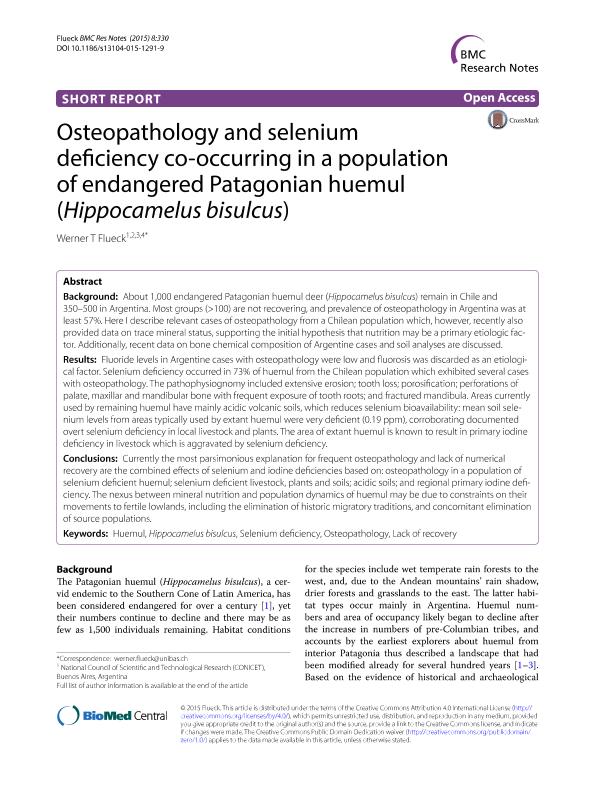Mostrar el registro sencillo del ítem
dc.contributor.author
Fluck, Werner Thomas

dc.date.available
2021-03-01T16:07:16Z
dc.date.issued
2015-08
dc.identifier.citation
Fluck, Werner Thomas; Osteopathology and selenium deficiency co-occurring in a population of endangered Patagonian huemul (Hippocamelus bisulcus) Veterinary Research; BioMed Central; BMC Research Notes; 8; 1; 8-2015; 1-9
dc.identifier.issn
1756-0500
dc.identifier.uri
http://hdl.handle.net/11336/127010
dc.description.abstract
Background: About 1,000 endangered Patagonian huemul deer (Hippocamelus bisulcus) remain in Chile and 350-500 in Argentina. Most groups (>100) are not recovering, and prevalence of osteopathology in Argentina was at least 57%. Here I describe relevant cases of osteopathology from a Chilean population which, however, recently also provided data on trace mineral status, supporting the initial hypothesis that nutrition may be a primary etiologic factor. Additionally, recent data on bone chemical composition of Argentine cases and soil analyses are discussed. Results: Fluoride levels in Argentine cases with osteopathology were low and fluorosis was discarded as an etiological factor. Selenium deficiency occurred in 73% of huemul from the Chilean population which exhibited several cases with osteopathology. The pathophysiognomy included extensive erosion; tooth loss; porosification; perforations of palate, maxillar and mandibular bone with frequent exposure of tooth roots; and fractured mandibula. Areas currently used by remaining huemul have mainly acidic volcanic soils, which reduces selenium bioavailability: mean soil selenium levels from areas typically used by extant huemul were very deficient (0.19 ppm), corroborating documented overt selenium deficiency in local livestock and plants. The area of extant huemul is known to result in primary iodine deficiency in livestock which is aggravated by selenium deficiency. Conclusions: Currently the most parsimonious explanation for frequent osteopathology and lack of numerical recovery are the combined effects of selenium and iodine deficiencies based on: osteopathology in a population of selenium deficient huemul; selenium deficient livestock, plants and soils; acidic soils; and regional primary iodine deficiency. The nexus between mineral nutrition and population dynamics of huemul may be due to constraints on their movements to fertile lowlands, including the elimination of historic migratory traditions, and concomitant elimination of source populations.
dc.format
application/pdf
dc.language.iso
eng
dc.publisher
BioMed Central

dc.rights
info:eu-repo/semantics/openAccess
dc.rights.uri
https://creativecommons.org/licenses/by/2.5/ar/
dc.subject
HIPPOCAMELUS BISULCUS
dc.subject
HUEMUL
dc.subject
LACK OF RECOVERY
dc.subject
OSTEOPATHOLOGY
dc.subject
SELENIUM DEFICIENCY
dc.subject.classification
Conservación de la Biodiversidad

dc.subject.classification
Ciencias Biológicas

dc.subject.classification
CIENCIAS NATURALES Y EXACTAS

dc.title
Osteopathology and selenium deficiency co-occurring in a population of endangered Patagonian huemul (Hippocamelus bisulcus) Veterinary Research
dc.type
info:eu-repo/semantics/article
dc.type
info:ar-repo/semantics/artículo
dc.type
info:eu-repo/semantics/publishedVersion
dc.date.updated
2021-02-26T19:18:10Z
dc.journal.volume
8
dc.journal.number
1
dc.journal.pagination
1-9
dc.journal.pais
Reino Unido

dc.description.fil
Fil: Fluck, Werner Thomas. Administración de Parques Nacionales. Parque Nacional "Nahuel Huapi"; Argentina. Universidad de Basilea; Suiza. Consejo Nacional de Investigaciones Científicas y Técnicas. Centro Científico Tecnológico Conicet - Patagonia Norte; Argentina
dc.journal.title
BMC Research Notes
dc.relation.alternativeid
info:eu-repo/semantics/altIdentifier/doi/http://dx.doi.org/10.1186/s13104-015-1291-9
dc.relation.alternativeid
info:eu-repo/semantics/altIdentifier/url/https://bmcresnotes.biomedcentral.com/articles/10.1186/s13104-015-1291-9
Archivos asociados
